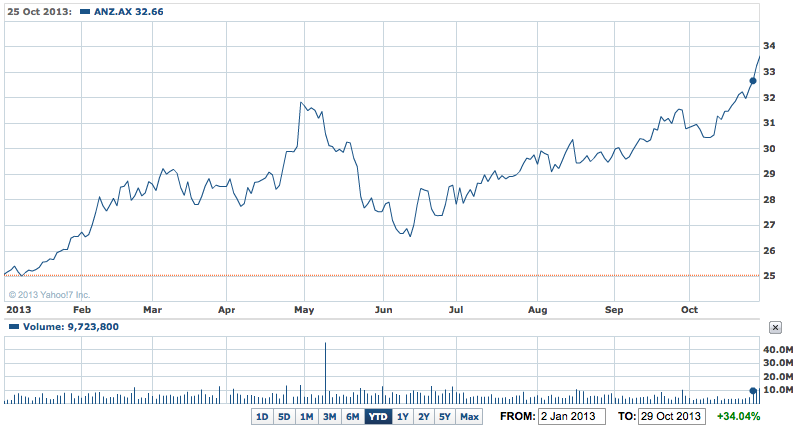First the ANZ tops expectations, will the National Australia Bank follow tomorrow?
Despite yesterday’s bout of market weakness, there are plenty of investors who reckon the NAB has good news for its shareholders as the ANZ did yesterday with higher earnings and dividend, and an expectation of more to come in the coming year.
ANZ shares ended at a new all time high yesterday afternoon.
They ended up 39 cents, or 1.2%, to $33.63, but the NAB finished flat at $36.68, Westpac dropped one cent to $34.60 and Commonwealth Bank was 61 cents lower at $76.79.
But they hit an intra day high of $34.06 during the early bullish trading. The shares turned down in the afternoon and ended close to their lows.
The ANZ lifted cash earnings (which strips out one off items and non cash items) by 11% to $6.49 billion in the year to September 30 and will pay shareholders a bigger than expected dividend which is up 13% in total.
The bank said directors had approved a final, fully-franked, dividend of 91c a share, which will take its full-year distribution to $1.64 a share, up from $1.45 last year.
Statutory net profit rose to $6.27 billion from $5.66 billion the year before. Revenue rose just 3% to $18.378 billion and the bank’s net interest margin fell to 2.22% at September 30 from 2.31% a year earlier and 2.24% at the end of the first half on March 31 this year.
Behind the improvement was an 18% fall in gross asset impairment (but it slowed in the second half to be down less than 10%) and a 22% drop in newly impaired assets. The individual provision charge was down 17% compared with September 2012, but the rate of decline slowed to 5% in the second half as well from the March half year.
And a 10% cut in operating costs helped offset the contraction in net interest margin.
ANZ said its Australian division increased profit by 11%, driven by income growth and a drop in costs, while profit in New Zealand jumped 29% thanks to credit quality improvements. The international and institutional banking arm of ANZ grew profit for the year 15% in the year to September.
ANZ YTD – ANZ hits records and supports share surge this year

"Today, the continued shift of global growth to Asia means that our strategy focused on building an Asia-connected bank makes more sense than ever," CEO Mike Smith said in yesterday’s commentary with the profit statement.
"It is creating growth options in all our businesses by allowing us to better meet the needs of customers by capturing the banking opportunities linked to regional capital, trade and wealth flows."
Meanwhile, the bank’s global wealth division lifted its profit 36%, thanks to more ANZ customers using its wealth solutions products.
The ANZ gave limited profit guidance, but Mr Smith said there was "more gas in the tank" for the bank.
Markets took that to be a positive, especially when he said the bank had a target of lifting its return on equity from the 15.3% in 2012-13 to 16% or more by the end of the 2016 year.
Mr Smith argued that the result also showed its push to become a “super regional” bank across Australia and the Asia Pacific was starting to pay off.
“This is a strong domestic performance, the result of a distinctive long-term strategy focused on growth in our domestic franchises and targeted expansion in Asia,” he said in the statement.
"Importantly, the long-term nature of what we are building at ANZ means there is still more gas in the tank."
The final payout ratio is just shy of 70% of profit and Mr Smith yesterday suggested it would remain at that level for a while.
“The board believes that a full year dividend payout ratio of between 65 per cent and 70 per cent of cash profit is sustainable in the medium term,” he said.
Despite credit growth remaining weak, ANZ’s net loans and advances rose 10% and customer deposits were up 12% in the year. Deposits funded 65% of loans in the year, the bank said.
It has also been aggressive in cutting jobs, with the ratio of costs to income falling by almost 3 percentage points to 44.8%.
The takeaways from this result are: a higher dividend for the coming year might happen, but will be dependent on earnings growth – so at best a small rise.
The bank will have to either drive more revenue offshore in Asia because the main driver in earnings growth in the past few years (falling bad and doubtful debts which have helped boost earnings) seems to be ending. The slower rate of fall in the second half in impaired assets is a warning and with unemployment on the rise, don’t expect another year where this area is an earnings driver of any significance.
New Zealand should be a concern simply because the Reserve Bank of NZ is worried about the country’s housing boom and might take tougher measures to slow it if those already introduced do not work. But the rest of the NZ economy is doing well, in fact it’s much stronger than Australia is at the moment.
And the Australian housing market will be the most obvious source of new revenue and earnings growth for the ANZ here, so long as prices do not get out of hand. Sydney and Melbourne are causing concern, but not other markets.













